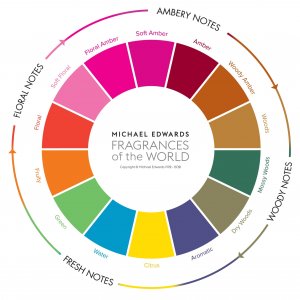The fragrance wheel, which is also known as an aroma wheel, fragrance circle, perfume wheel and other monikers is a circular diagram that explains the differences and similarities among diverse olfactory families.
While our perfumes at Alpha Aromatics, many of which have been working with scent formulations for more than seventy years, can easily recognize which family or sub-family a fragrance belongs to with just one sniff, for others it is not so easy.
Early versions of the fragrance wheel date back to 1949, when the first example was conceived by Austrian perfumer, Paul Jellinek.
It was named The Odor Effects Diagram, and it was published in his book The Practice of Modern Perfumery.
Other notable versions appeared across the very fragrant horizon in 1979 with The Fragrant Circle that was developed by U. Harder at Haarman and Reimer, and later in 1984 with sensory chemist, Ann C. Noble’s version, The Wine Aroma Wheel.
The version of fragrance wheel that is in use today is the 1992 brainchild of expert perfumer and taxonomist, Michael Edwards.

It has evolved over the decades, reflecting dynamic and conventional fragrance and the way humans perceive smell.
Edwards is also the author of Fragrances of the World, which makes him a world leader in the field of fragrance classification.
This wheel is reminiscent of the color wheel that many art classes displayed in schools everywhere that place colors in accordance to their relationship to one another.
One color blends into the next and opposite colors clash.
There will always be staple scents that complement each other that are familiar to everyone, but sometimes a company producing a specific product may need to experiment with a few different fragrances to find exactly what they seek and that can be an easier task with just a touch of direction from the fragrance wheel and the expertise of the researchers at Alpha Aromatics.

Scent, like color, has categories that determine which fragrances will mesh well together.
The fragrance wheel works in much the same fashion, and is an expedient tool in determining both fragrance attraction and the connection between scent preferences and their diverse families.
The wheel is split into four sections, and they are: Floral, Oriental (now referred to as Amber), Woody and Fresh.
Each family contains aromas that are similar to each other, share the same characteristics or have complementary aspects.
Under each family are sub groups, which describe a particular scent in much detail. Where they are placed on the wheel is important.
For example, a floral scent, with the addition of certain notes, will become a soft Floral.
Perfume lovers tend to prefer scents from only one or two families, although there may be emotional connections to others.

For retailers, business and office managers as well as home owners, learning how to classify scents and how to pair them with others is essential to olfactory harmony wherever the scent is placed.
The fragrance wheel can demystify the power of strategic scent placement because it clearly indicates which aromas blend well with each other and which clash.
While there is some discrepancy over the organization and description of each family among experts within the industry, most agree to the following families and subfamilies.
Further clarification is detailed below.
The Scent Families Of The Fragrance Wheel
Floral
With aromas reminiscent of freshly cut flowers, some of the most popular fragrances in the world belong in this sector.
They are considered feminine, and contain captivating notes like haunting jasmine, bright lily and musky romantic rose.

These fragrances can be surprisingly complicated and delicate at the same time, depending on the scent’s intensity and the other notes that are added to the blend.
Sub families include:
1. Floral Fresh
These fragrances contain fresh, flowery aromas of woody, smoky rose or spicy, bright lily.
2. Soft Floral
These formulations are known for their aldehydes and powdery notes.
3. Floral Ambery
These scents are mostly limited to facets of fresh, floral orange blossom and assorted sweet spices.
Amber (previously referred to as Oriental)
Most perfumers consider this to be the most luxurious fragrance family.
Amber fragrances feature full, rich scents with sugary, piquant notes such as: powdery, vanilla-like orchid, noble and lush vanilla, spicy, inviting cinnamon and aromatic and spicy cardamom.
These fragrances are highly sensual and exotic.
Sub families include:
1. Ambery
These aromas are marked by musky notes like vanilla, resins or cinnamon.
2. Soft Ambery
These light fragrances are blended with floral and anise notes.
3. Woody Ambery
These scents are earthy and sweet and often mixed with smooth and creamy sandalwood or earthy patchouli.
Woody
Warm, opulent aromas with tones of buttery, powdery sandalwood, dark, rich amber or dry, somewhat sugary cedar wood characterize scents within this fragrance family.
Due to the inherent sweetness of the woody notes, perfumers often blend them with floral and fresh notes, which render compositions that are a bit lighter and brighter.
Subfamilies include:
1. Woody
Mostly sandalwood and patchouli
2. Mossy Woods
These light scents are smooth, mellow and earthy.
3. Dry Woods
This sub family usually features creamy sandalwood with smoky notes like soft, pungent leather.
4. Aromatic
Woody tones combined with aromatic fresh fragrances like lavender, which is a subcategory that is between the woody and fresh scent families on the aroma wheel.
Fresh
This scent family includes some of the world’s most refreshing and vibrant fragrances.
They are defined by bright, citrus-based, oceanic, herbal, green notes. that are often bolstered by lingering woodsy elements.
They are often used in air freshener products because of their clean, bright character and more often found in masculine than feminine fragrances.
More sophisticated scents are usually blended with spicy notes, and a mélange of tart, aromatic fragrances with fruity and zesty accents are also prevalent within this scent family.
They can include: piquant, pleasing bergamot, earthy, savory and nutty sage and uplifting grapefruit.
Sub families include:
1. Aromatic
Also known as fougère, these fragrances are clean, simple and fresh. They often feature blends of sharp, clean rosemary and spicy, herbal basil with facets of mellow lavender and warm, woody notes.
2. Citrus
These zesty, bright fragrances are usually formulated with elements of complex bergamot, invigorating citrus, lush orange, juicy mandarin and uplifting grapefruit.
3. Water
Marine and aquatic notes dominate this sub family.
4. Green
This category includes invigorating, fresh, herbal and leafy smells blended with the scent of green leaves or a freshly mowed lawn.
5. Fruity
Technically, this is a subcategory that lies between the fresh and floral scent families on the fragrance wheel. Essentially, it is comprised of sweet aromas containing notes of velvety peach, dense, slightly sugary pear and crisp apple.
How To Use The Fragrance Wheel
All perfume families create their own specific ambiance, and understanding how to use the scent wheel when deciding what type of scents to add to your office or home will allow for the selection of aromas that match each other and help to harmonize the environment.
Even reading the descriptions of the various sub-families can and usually does spark an attraction for individual preferences.
The opposite is also true in terms of negative reactions to particular smells.
Every scent family has its unique features, and personal appeal will always lure one to select one fragrance over another.
Begin the learning process of selection by choosing familiar perfumes and checking out their ingredients.
Then seek out those same facets on the fragrance wheel.
These can serve as a guide to pairing neighboring fragrances that contain the same type of notes.
Selections rarely fall within one scent family, and sometimes, perfumes blend well with other families, especially those that are situated side-by-side on the fragrance wheel.
The Floral and Fresh perfume sectors, for example, stand out as those that are most commonly found together.
3 Important Tips When Using The Fragrance Wheel
The following three important tips twill help unlock the mystery of the fragrance wheel.
- Choose Opposite Scents – Once the selection has been made as to the preferred fragrance subfamily, it can then be paired with one that is across from it on the aroma wheel. The resulting fragrance is certain to please and delight.
- Select Fragrances That Are Side by Side On The Fragrance Wheel
- Pick Aromas That Form A Triangle – Selecting three fragrances that create a triangle while looking at the wheel will usually complement each other nicely and will determine a pleasant olfactory experience.
Alpha Aromatics and The Fragrance Wheel
We are both a pioneer and leader within the modern perfume industry who’s routes stretch as far back as the trying aftermath of World War II.
Our focus has remained unchanged over the passage of time, which is in the words of chief chemist and perfumer, Roger Howell, “to build great scents that build great brands.”

Located in suburban Pittsburgh, Pennsylvania, we are known for our ability to transform the mission of any commercial enterprise into an unforgettable olfactory communion between products and the often fickle noses of consumers.
We showcase modern brands and help to build consumer loyalty both with the creation of our vast array of supreme scents and our unswerving business strategy, which is focused on meeting the dynamic needs of the global perfume industry marketplace.
Our unique organic, natural and designer fragrances are integral to many personal care products, candles and diffusers, fragrances for home, odor neutralizers, private label brands, industrial air fresheners, household cleaning products and fine, customized perfumes.

The following are a few examples of our recently-composed fragrances; one from each family of scents.
Ambery
Santal White Tea
Intense and enticing, Santal White Tea unfolds with a top note brimming with aspects of bitter, spicy and fruity bergamot, slightly sugary and piquant cardamom, raspberry-nuanced iris and minty, green and fresh eucalyptus.
These elements soon surrender to a heart note bouquet marked by facets of crisp, verdant and sweet white tea, powdery violet, musky, romantic rose and elegant and lush vanilla.
The scent completes with base notes featuring earthy musk, sensual and spicy cashmere, warm, dry cedar wood and creamy sandalwood.
Fresh
Sea Salt Pomelo
Inspired by the vast majesty of the endless sea, this sophisticated scent streams with opening notes bursting with facets of dry, keen citron, sweet, floral and pleasing bergamot, fine, clean pomelo and ozonic sea salt.
A middle note soon follows with aspects of woody, dusty violet, intense and intoxicating jasmine and tender, woody-nuanced sea moss.
A robust base note flowing with facets of sun-baked driftwood, sensual musk and sweet, marine-tinged ambergris finish this compelling fragrance.
Floral
Natural Honeysuckle Bloom
A citrus rush of ambrosial, acidic citron and lush orange open this exhilarating fragrance, reminiscent of exotic, far away places.
These facets soon fade into a heart note characterized by haunting, narcotic jasmine, romantic, musky rose, piquant, somewhat grassy carnation and honey-tinged, lush and sweet honeysuckle.
The scent finishes with a base note comprised of slightly powdery and buttery sandalwood and crisp, dried herbs.
Woody
Santal Black Currant
This bold fragrance opens with a surge of fruity/ floral aspects of sweet, slightly spicy banana, woody-tinged and and pungent cardamom, dusty, woody violet, raspberry-nuanced iris, and fresh, peppery leafy green.
A redolent, berry heart note soon appears that is hallmarked by facets of sharp, biting black currant, cozy, fruity and inviting cinnamon and crunchy apple.
Aspects of warm, dry cedar wood, dark musky patchouli and smooth, velvety sandalwood complete this robust scent.
In Conclusion
No mater what message your company may wish to convey to customers, we can make the selection for ambient scenting much easier by creating unique and appealing fragrances based on the fragrant truths found on the aroma wheel
Call our teams today for the most fragrant solutions tomorrow!

Photo Credits: Pixabay
 alpha aromatics®
alpha aromatics®